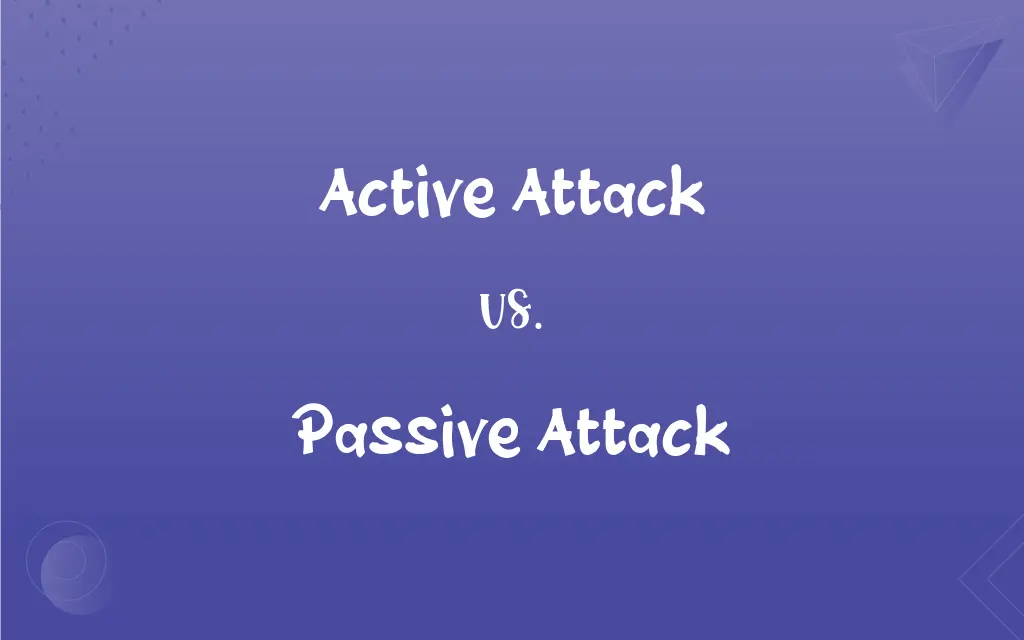Active Attack vs. Passive Attack: What's the Difference?
Edited by Janet White || By Harlon Moss || Updated on October 25, 2023
An active attack alters system resources or affects data, while a passive attack eavesdrops without making changes.

Key Differences
In the realm of cybersecurity, active attack and passive attack represent two primary modes of unauthorized interventions. An active attack involves an attacker making direct changes to data or system configurations. In contrast, a passive attack focuses on secretly listening to and gathering information, without any alteration to the data.
An active attack not only breaches a system's security but also leaves a discernible trail due to its intrusive nature. For example, a hacker might corrupt a system file, block services, or introduce malware during an active attack. Meanwhile, a passive attack is stealthier. An attacker employing a passive attack might simply monitor communication channels, collecting information without leaving obvious signs of their intrusion.
The danger of an active attack lies in its capability to cause immediate harm. It can disrupt normal system operations, damage data integrity, or even render services unusable. In contrast, the threat posed by a passive attack is more latent. Even though a passive attack doesn't alter data, it can lead to information leakage, which may subsequently be exploited in other attacks.
Detection methods for both attacks vary due to their distinct natures. Active attacks, due to their overt and disruptive nature, can often be detected by intrusion detection systems or by noticing unusual system behaviors. Passive attacks, given their covert nature, are trickier to spot and might require traffic analysis or advanced monitoring tools to identify.
In essence, while both active attack and passive attack threaten system security, they differ in approach, impact, and detection. Active attacks intervene and modify, whereas passive attacks silently observe and collect.
ADVERTISEMENT
Comparison Chart
Nature
Intrusive and alters data/systems.
Stealthy and gathers data without alteration.
Impact
Can cause immediate harm and disruption.
Leads to information leakage which may be exploited later.
Detection Difficulty
Often easier to detect due to its overt actions.
Harder to detect due to its covert nature.
Example
Injecting malware into a system.
Monitoring communication channels for information.
Purpose
To damage, disrupt, or gain unauthorized control.
To listen, observe, and gather information covertly.
ADVERTISEMENT
Active Attack and Passive Attack Definitions
Active Attack
Active attack disrupts normal operations.
Blocking users from accessing their accounts is an active attack.
Passive Attack
Passive attack often gathers information for later use.
Capturing network traffic to decode encrypted messages later is a passive attack.
Active Attack
Active attack may alter or damage data.
Introducing malicious code to corrupt files is an active attack.
Passive Attack
Passive attack is covert in nature.
Using a tool to monitor Wi-Fi traffic without disrupting it showcases a passive attack.
Active Attack
Active attack involves direct intervention in a system.
A hacker modifying a website's content exemplifies an active attack.
Passive Attack
Passive attack does not alter the data.
Eavesdropping on a confidential conversation without intervening is a passive attack.
Active Attack
Active attack is overt in nature.
Denial of Service (DoS) attacks, which crash services, are considered active attacks.
Passive Attack
Passive attack focuses on secret observation.
A spyware that logs user keystrokes without interfering is conducting a passive attack.
Active Attack
Active attack seeks unauthorized control or access.
Hacking into a secured database to change records represents an active attack.
Passive Attack
Passive attack aims at data leakage.
An unauthorized entity accessing a video feed without changing its content is executing a passive attack.
FAQs
Are passive attacks harmless?
While passive attacks don't alter data, they can lead to significant information leaks, which may be exploited later.
What is an active attack?
An active attack involves direct changes to data or system configurations without authorization.
What characterizes a passive attack?
A passive attack involves secretly listening to and gathering data without making alterations.
Can passive attacks be detected?
Yes, though they are harder to detect and might require specialized tools or traffic analysis.
Is data encryption effective against passive attacks?
Yes, encryption can prevent unauthorized entities from understanding intercepted data during a passive attack.
Is data alteration a sign of an active attack?
Yes, unauthorized data alteration indicates an active attack.
Can active attacks be used to distract from passive ones?
Yes, attackers might use an active attack as a diversion while covertly conducting a passive attack.
Is malware introduction an active or passive attack?
Introducing malware is considered an active attack as it affects system resources.
What's more dangerous: an active or passive attack?
Both pose threats, but active attacks often have immediate harmful effects, while passive attacks have latent risks.
Is traffic analysis a method to detect passive attacks?
Yes, analyzing network traffic can help spot unauthorized data interceptions characteristic of passive attacks.
Which attack, active or passive, is harder to trace back to the perpetrator?
Passive attacks, due to their stealthy nature, are generally harder to trace.
Can a passive attack be a precursor to an active one?
Yes, information gathered during a passive attack can be used for a subsequent active attack.
Are Denial of Service (DoS) attacks considered active?
Yes, because they actively disrupt services.
Can firewalls prevent active attacks?
Firewalls can block many active attacks but might not prevent all, especially if vulnerabilities exist.
Are passive attacks always silent and unnoticed?
While passive attacks aim to be covert, sophisticated monitoring tools or vigilant security practices can detect them.
How can one detect an active attack?
Active attacks, due to their disruptive nature, can be detected by intrusion detection systems or unusual system behaviors.
How can one mitigate the risks of passive attacks?
Regularly updating software, using encryption, and employing intrusion detection systems can help.
How can organizations protect against active attacks?
Regular security audits, updates, and employee training can help safeguard against active threats.
Why are active attacks more noticeable?
They directly alter or disrupt system operations, leaving a more evident trail.
What's the main goal of a passive attack?
The primary aim is covert information collection without altering or disrupting the data.
About Author
Written by
Harlon MossHarlon is a seasoned quality moderator and accomplished content writer for Difference Wiki. An alumnus of the prestigious University of California, he earned his degree in Computer Science. Leveraging his academic background, Harlon brings a meticulous and informed perspective to his work, ensuring content accuracy and excellence.
Edited by
Janet WhiteJanet White has been an esteemed writer and blogger for Difference Wiki. Holding a Master's degree in Science and Medical Journalism from the prestigious Boston University, she has consistently demonstrated her expertise and passion for her field. When she's not immersed in her work, Janet relishes her time exercising, delving into a good book, and cherishing moments with friends and family.































































